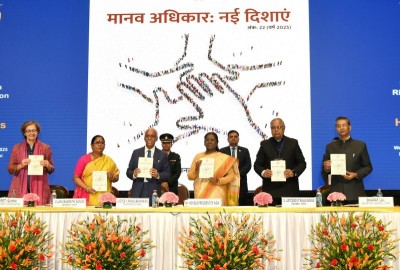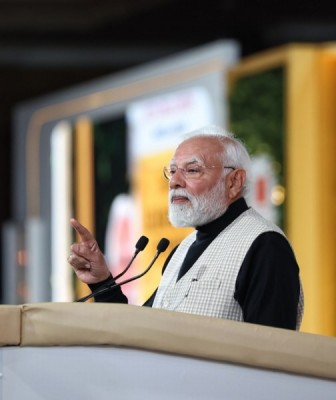
Punjab: Complacence Kills
There are few surprises here: preliminary evidence, including data on two GPS devices recovered from the slain terrorists, indicates that they entered India from the Shakargarh area of Pakistan; while conclusive identification is yet to be made, there is little doubt that these are Islamist terrorists; the pattern of the attack bears striking resemblance to a succession of so called fidayeen attacks in Jammu & Kashmir (J&K); the Centre claims that it had been warning Punjab of an imminent attack for some time; the Punjab Chief Minister Parkash Singh Badal claims that the Centre provided no intelligence of any impending threat and had also failed in its duty to prevent infiltration across the international border. Union Home Minister Rajnath Singh has declared, once again, that India would give a "befitting reply" to this new provocation from Pakistan. Nevertheless, initial reports suggest that talks with Pakistan are to continue and the scheduled meeting of Prime Ministers Nawaz Sharif and Narendra Modi in 2016 is still on. Jitendra Singh, Minister of State in the Prime Minister's Office, speaking even while the operation was ongoing, asserted that Pakistan's Inter-Services Intelligence (ISI) - the principal sponsor of terrorism in the South Asian region - was likely to be behind this latest attack. Several commentators also speculated that the terrorists were probably affiliated to the Lashkar-e-Taiba (LeT), the Islamist terrorist formation that has long enjoyed the open and enthusiastic support of the Pakistani state.
All this is par for the course, but there are elements that need closer attention. First, the attack is widely being spoken as an aberration, because it occurred in Punjab; others are speaking of it as an 'overflow' from J&K, the 'principal target' of the Pakistan-backed Islamist terrorists. There is a deeply erroneous reading of the situation here. Over the past years, locations across India have been targeted by the Islamist terrorists; these are not just attacks 'in J&K', or 'on Mumbai' or 'on Bodh Gaya' or 'on Gurdaspur'; State, city or district jurisdictions may have relevance in terms of tactical responses, but it is folly to believe that the ambitions or the operations of our enemies are in any way circumscribed by these internal arrangements. These attacks are systematically directed against India. Specific targets may be dictated by transient considerations of capacity, tactics or opportunity; but at core, this is a long term strategy to weaken India on every possible occasion, by every available device. Regrettably, our leaderships, particularly in the political, security and intelligence spheres, tend to lapse quickly into complacence regarding regions that are not subjected to sustained violence, despite visible vulnerabilities and threats. Gurdaspar is an obvious case in point; this is an area bordering Pakistan, with a history of volatility, significant vulnerabilities along the border, particularly to drug smuggling - another 'industry' actively supported by the Pakistani state; and disturbing legacies of deep involvement in the Khalistani terrorist movement that ravaged Punjab for over 13 years, through the 1980s and early 1990s. There have been continuous intelligence flows indicating that the ISI has been pressuring the many 'rump elements' of the defeated Khalistani movement - who Pakistan continues to host and fund in the hope of a possible revival - demanding that they 'do something' in Punjab to earn their keep. That they have failed is proof of the degree to which their ideology and networks were completely defeated in Punjab, the complete absence of traction that their occasional efforts have met, and the capacities and penetration that the Punjab Police and intelligence continue to retain. Nevertheless, Pakistan's intentions and objectives in Punjab have never been in doubt, and the prospect that they could employ different instrumentalities - including the Islamist terrorists in their stables - is something we should have been completely prepared for, and utterly unsurprised by.
Our focus on ISI in the frenzied discussions that follow every new attack is also at least partially misdirected and strategically misleading. The ISI, in particular, has been magnified in the popular imagination into a formidable, indeed, monstrous entity. But this is the same ISI that we defeated comprehensively in Punjab. This is no remarkable, invincible organisation. But despite our national obsession with the ISI, its capacities and its proxies have never been the target of a sustained national strategy and campaign. We have reacted in isolation, locally, to each of its provocations; and slunk back into grateful complacency whenever and wherever we have been spared its venomous attention for any length of time. This is hardly the approach that is going to counter, leave alone defeat, a relentless adversary operating under an ideology of uncompromising hatred based on a deeply held, albeit perverse, Faith.
Crucially, however, our problem is not the ISI alone. Islamist terrorists the world over are, today, operating under the umbrella of an overarching Islamist terroristInternationale, of which ISI is as much a part as is the Islamic State (IS, formerly Islamic State of Iraq and al Sham, ISIS), al Qaeda, and numerous rag tag Islamist terrorist formations that are proliferating across the world. These groups are not working in isolation, nor is Pakistan their only state sponsor. The virulent ideology of Islamist extremism that underpins all Islamist terrorist groups is shared by numerous states - most prominently including Pakistan and Saudi Arabia. While these states and the many 'non-state actors' may have their own turf wars, disputes about command and control, about priorities, and about tactics, on ideology and in broad strategic orientation, this is a single complex. And as far as India is concerned, there is an identity of purpose across this entire complex: this is a 'region of disbelief', a land where the kafir has escaped rightful Islamist domination, and a necessary theatre of 're-conquest'. Billions of petro-dollars, injected overwhelmingly through a range of illegal channels, have, over the decades, funded the proliferation of Wahabi-Salafistsmosques and madrasas across India, and particularly in its most sensitive and unstable concentrations - including J&K and along other vulnerable borders. We may, for the moment, rejoice in the fact that very few Indians have been tempted to join IS in Iraq and Syria - but hundreds have certainly gone across to join jihadi groups in Pakistan and Afghanistan. To believe that the hundreds of thousands of Indians who are currently being exposed to the distorted doctrines of Salafist and extremist Islam, will forever remain impervious to the seduction of the siren song of the Islamist terrorist jihad, is to ignore the violent realities that are sweeping across West Asia, North Africa and parts of South Asia today, and that have deeply infected even the tiny populations of Muslims in the affluent West.
There is one aspect of the Dinanagar incident that is of significance in this context. Some criticism is now being levelled against the Punjab Police, both for its decision to keep the better equipped and trained Indian Army and National Security Guard (NSG) out of the operation, as well as for various aspects of its own response. A tactical response assessment, based on a minute by minute examination of responses of this entire operation must, of course, precede any authoritative and prudent critique; but certain deficiencies were clearly visible. The absence of protective gear among even the 'elite' Special Weapons and Tactics (SWAT) team leading the response; poor training visible in the clustering of groups of policemen, in postures during firing, in their movements, and some morbidly obese individuals in the Force, are all elements that have been swooped down upon by those who seek to highlight the negatives - and rightly so. But the determination of the Punjab Police and its leadership to handle the response on its own, despite the presence of better equipped, better protected and better trained teams of central Forces on location, and despite some pressure to deploy these, is commendable. The Director General of Police, Sumedh Singh Saini chose to lead from the front and whatever one may say of the quality of the response of his men, their motivation, their dedication to the task, their courage, and indeed, even the pugnacious attitude of some of the wounded, cannot be denied. This is a tremendous change from the characteristic whining and complaining by most State Police Forces in the wake of a terrorist incident, and the eagerness with which an intervention by central Forces is awaited and accepted.
Despite the visible deficiencies of the response of the Punjab Police, this is the only sustainable model to protect against the depredations of terrorists and extremists of various hues across unpredictable locations across the country. The Army and NSG cannot be everywhere, and cannot be deployed within an acceptable time frame at every new location of terrorist attack. Local authorities cannot, and must not, wait interminably for the Centre to send in appropriately trained or equipped Forces. The local Police, the first responders, must be ready, willing and highly motivated to react immediately and effectively on their own, and must take rightful pride in so responding. Every crisis across India cannot be handled from New Delhi. Decentralization is absolutely necessary, certainly in security matters.
There is tremendous latent danger in our regional environment and across the world today. The threat has been substantially contained within India, but it would be unwise to assume that this will forever remain the case. Police Forces and local intelligence across the country - and including Punjab - have been subjected to a continuous process of deprivation and decay. There must be a concerted effort, now, to strengthen the working of all Police Stations, their fortification, the improvement of personnel profiles and capabilities, technologies, weaponry and processes. This will not only be our most effective response to the challenge of terrorism, it will bring about a comprehensive transformation in the security profile of the country.
Our greatest threats lie in the weakness, the corruption and the degeneration of our own institutions and leaderships. We must, of course, defend against the machinations of our external enemies; but we must protect, even more urgently, against the enemy within.
Support Our Journalism
We cannot do without you.. your contribution supports unbiased journalism
IBNS is not driven by any ism- not wokeism, not racism, not skewed secularism, not hyper right-wing or left liberal ideals, nor by any hardline religious beliefs or hyper nationalism. We want to serve you good old objective news, as they are. We do not judge or preach. We let people decide for themselves. We only try to present factual and well-sourced news.







